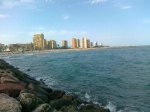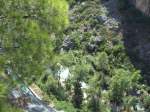
For bigger size click on the map
Soroca (Russian: Сороки Soroki, Ukrainian: Сороки Soroky, Polish: Soroki) is a Moldovan city situated on the Nistru River about 160 km north of Chişinău. It is the administrative center of Soroca District.
The city has its origin in the medieval Genoese trade post of Olchionia, or Alchona. It is known for its well-preserved stronghold, established by theMoldavian Prince Stephen the Great (Ştefan cel Mare in Romanian) in 1499. Its name is derived from the Slavic word for magpie.
The original wooden fort, which defended a ford over the Dniester/Nistru, was an important link in the chain of fortifications which comprised four forts (e.g. Akkerman and Khotin) on the Dniester, two forts on the Danube and three forts on the north border of medieval Moldova. Between 1543 and 1546 under the rule of Petru Rareş, the fortress was rebuilt in stone as a perfect circle with five bastions situated at equal distances.
During the Great Turkish War, John Sobieski‘s forces successfully defended the fortress against the Ottomans. It was of vital military importance during the Pruth Campaign of Peter the Great in 1711. The stronghold was sacked by the Russians in the Russo-Turkish War (1735–1739). The Soroca fortress is an important attraction in Soroca, having preserved cultures and kept the old Soroca in the present day.
The locality was greatly extended in the 19th century, during a period of relative prosperity. Soroca became a regional center featuring large squares, modernized streets, hospitals, grammar schools and conventionalized churches. In the Soviet period the town became an important industrial center for northern Moldova.
Source: Wikipedia
Travel journal
After a cold, long winter, without travelling and having new experiences, came the most wanted time for tripping under a big, hot spring sun.
We decided very quickly the new destination of the day: Soroca, a small Moldavian town where is the famous fortress of Stephen the Great of Moldavia- one of the most visited place in Moldova. The morning was sunny and pretty nice, so we had the necessary mood to travel.
We took the bus (in fact, it was a minibus, a very common transport inMoldova) Chișinău-Soroca from the North bus station; the ticket cost 60 lei (4 Euros) and we gave the money directly to the driver. During the itinerary, the driver allowed persons to travel without seats and it was a bit uncomfortable for us (even if we had places to stay) because of the heat form the bus. We traveled almost 2.5 hours by bus; it wasn’t as boring as we thought it would be! Holding hands, we saw beautiful landscapes, nice, Romanian villages with nice people who were carrying for their households. We saw the village of my grandparents and we remembered our childhood when we were staying during our vacations at our grandparents, looking for new adventures.
After we traveled through Telenești County, the road became very bad, in Florești County, it was impossible not to pay attention on it. Finally, after 2.5 hours, we arrived in Soroca and we stopped near to the final station of the buses from the city.
As we were very hungry, we started to look for a restaurant or place to eat. We found one were we ate some tasty Colțunași (пельмени-pelmeni) with cheese which cost 13.5 lei (almost 1 Euro). The next thing we did was to take the bus nr.1 (we paid for 2 tickets 4 lei which means 1 Romanian Leu, almost quarter Euro) which took us in Soroca Nouă (New Soroca)-the part of the city where is situated the Fortress.
After some minutes, we were near the fortress. We were so excited! As we were approaching to it, we noticed a lot of cars and people in front of the fortress. When we entered, we saw a lot of children, women, men and priests present at an Easter challenge, where the participants should sing. It was interesting to watch the show and to see the people’s faces, but we came at Soroca to see the fortress, so we paid more attention on it.
We made a lot of photos, we noticed the well-kept fortress and we tried to imagine how our ancestors were defending this building. Soroca is placed on the shore of river Nistru (on the other side beginsUkraine), so the landscape is fabulous! It’s a bit cold in the region of the fortress because of the water, but this sensation gives you a feeling of power and lordliness.
We had a nice, sweet walk, trying to find the road which takes us to the center of the city. During the stroll, we found a fountain and I asked him to take water out. After killing our thirst, we continued our way, straight to a big monument – Lumânarea Recunoștinței. In the city we saw some restaurants and shops-nothing special, just some places where you can pass the free time in a small city fromMoldova.
Well, if you want to see Lumânarea Recunoștinței’s monument, you may need a car, but if you don’t have it, you can do like us: walk almost 2 Km. We took the direction towards the entrance of the city, and we passed out Soroca. We had a short stoppage on the shore of Nistru, we saw some active fishes in the water, we talked, we made some photos and admired the beautiful landscape. We noticed also the border Moldova-Ukraine which was accessible only for the citizens of Ukraine and Moldova.
The monument we are talking about is situated at 1 Km from Soroca, at a high of 656 stairs (i counted them!). While climbing the stairs, appears a fantastic view of the Nature: the beautiful forests with the multitude of green nuances of the trees, the road made by Nistru, the multi-millennial rocks. There,at the alttitude, you have the feeling that you’re untouchable, strong and free to do whatever you want. Here you can do an oath, near your love, even it doesn’t have a spiritual ancestral value..
In the interior of the monument, which looks like a candle, you will fiind a little „church” without altar where is possible to keep the marriage ceremony.
After we made some photos, we went back to the city, at the bus station and we took the bus at 6:00 PM (we bought the tickets earlier, when we arrived in the city-just to be sure we’ll have good seats). The driver took persons without tickes, but we weren’t disturbed by that.
During the way back home (did you see this movie? J) we fell asleep, we talked, or we just were watching through the window and thinking at the day has just passed. In 2.5 hours we were in Chișinău, we stopped at a troleybus station, took the bus and came home tired and hungry.
We went together to bed thinking the day was nice , the trip was interesting & exciting and we should fiind the next destination of our trip. However, wish we could do more to improve our sensation of good…
Această prezentare necesită JavaScript.


























































































































